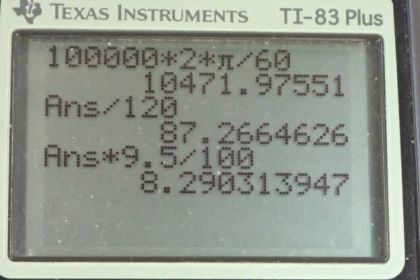Question
An ultracentrifuge accelerates from rest to 100,000 rpm in 2.00 min. (a) What is its angular acceleration in ? (b) What is the tangential acceleration of a point 9.50 cm from the axis of rotation? (c) What is the radial acceleration in and multiples of of this point at full rpm?
Final Answer
Solution video
OpenStax College Physics for AP® Courses, Chapter 10, Problem 2 (Problems & Exercises)

vote with a rating of
votes with an average rating of
.
Calculator Screenshots
Video Transcript
This is College Physics Answers with Shaun Dychko. An ultra-centrifuge starts with an angular speed of zero and accelerates up to a final angular velocity of 100,000 rpm and we are gonna take this moment where we are writing down the stuff that we know to do our unit conversions so that we don't have to worry about that later. So we are gonna multiply by 2π radians for every revolution so the revolution's cancel then multiply by 1 minute for every 60 seconds... this rpm is a bit of a strange unit, you don't really notice what's in the numerator or in the denominator but the 'per' can be rewritten as a slash and then the minute is in the bottom so this is revolutions per minute and so this minute cancels with this minute and this gives us radians per second here. So we end up with 1.04712 times 10 to the 4 radians per second and it does this acceleration from zero to this final angular speed in two minutes which we'll then convert into 120 seconds. Okay! Part (a) asks us for the angular acceleration so that is the change in angular velocity divided by time so that's this final angular velocity which should have some times 10 to the 4 beside it here the final minus initial here and divided by 120 seconds which is 87.3 radians per second squared. Then we are asked what is the tangental acceleration or the acceleration along the edge of the circle at a distance 9.50 centimeters from the axis of rotation. So we take this angular acceleration and multiply it by the distance from the center and that's 9.50 centimeters which we convert into meters and that's 8.29 meters per second squared. And then part (c) asks us for the radial acceleration which is another way of saying centripetal acceleration— acceleration towards the center— and that's the tangental velocity squared divided by the distance from the center or we can substitute ωr in place of v expressing this tangental velocity in terms of angular velocity and radius and this gives us ω squared r squared on the top, one of the r squared's cancels with this r on the bottom giving us ω squared r is our formula for centripetal acceleration. So we substitute v—final angular velocity—in here square that, multiplied by the distance from the center in meters and we get 1.04 times 10 to the 7 meters per second squared. So this acceleration is huge and that explains why centrifuges are capable of separating different materials in a test tube, for example... that's a typical use putting, you know, a material of a blood sample say in a test tube and then put it in a centrifuge and it will separate all the different parts out based on their densities. Okay! So this acceleration, expressed in g's, well, we have to multiply it by 1 g for every 9.8 meters per second squared and we are left with 1.06 times 10 to the 6 g's.

